My Aussie Visa Application and Norwegian Artist Hans Dahl
Red tape and Blue Waters make a calming combo
“Keep a cheerful temper, in storm and in sunny weather.” - Hans Dahl
Humility, after the first shock, is a cheerful virtue."
— C.S. Lewis (The Problem of Pain)
"Everybody needs beauty...places to play in and pray in where nature may heal and cheer and give strength to the body and soul alike."
— John Muir
(As always, if you’re here for the Artist, scroll down to the word ANYWAY to avoid my latest foibles at the start.)
What a week. It’s finally started getting hot here in Georgia. Meaning you can’t walk on pavement in your bare feet and when you drive, the heat shimmers off the road on the horizon in front of you.
I meant to mail my Australian visa application on Friday, then it was Saturday. I finally managed to get it in the mail yesterday- TUESDAY. Thank goodness it was only a self imposed deadline. Everything got a bit, umm, complicated for a while. I’m not going to go into the little bout of food poisoning. Let’s just say I didn’t want to sit at the computer and fill out forms for any period of time.
Back at my laptop after two days, I had to put my entire working life into little columns. I became grouchier as I typed up each memory - Berlin, Kaiserslautern, Grafenwoehr and Vilseck, Germany as well as Mons, Belgium. Happy days. I do better when I don’t look back, but this was unfortunately unavoidable. My sisters, brother and parents info also had to be included. Deeds and bank account statements to show that I’m living with my husband, as well as birth certificate, marriage license and Army discharge - DD 214- papers.
Next, I had to provide fingerprints for a background check. I could have them done at the police department, mail them to the FBI and wait two weeks, or I could go to the post office and send them digitally, with a two day turnaround for the report. You know which one impatient Fraulein Zen chose, right?
I decided to avoid the main post office, a huge, mildewed modern building with a too small parking lot and harried, poker faced USPS employees behind the counter going as slowly as turtles basking on a hot rock - and really, I get it! No matter how fast they go, the line never dies down. And the questions from customers at the main post office - they are complicated. Standing in the long stretch of resigned customers, you slowly lumber to the front and pray that the USPS employee isn’t due a break right before you arrive at the counter. It’s the seventh circle of Dante’s hell, for sure.
Fortunately, there’s a second fingerprint location within easy driving distance - the little Smiths Station, Alabama post office. It’s boxy and cute, old fashioned, fronted with a glass door and the same two men working the counter every day. It took BOTH of them to get my digital fingerprints to go through to the FBI for my background check - one smashed my digits onto the screen while the other cupped my hand from below to keep the pressure on long enough for the things to take. Apparently, they’ve had problems for a while but figured out a work around while waiting for the new equipment. Gotta love Southern ingenuity.
The FBI sent the necessary paperwork back a few days later - I have no federal record, but the G-men could NOT guarantee that I didn’t have a local or state pending conviction. Huh. Maybe the Australian visa office will take a look at my Albertina Einstein photo and decide that the likelihood of a crime spree is fairly improbable. Fingers crossed.
Let’s hope I don’t have another bad Visa experience. Surely one was enough. When I submitted paperwork to the New Zealand embassy back in 1998, my case was assigned to Mr. Wong. I will never forget him. We spoke on the phone several times while he tried to determine if I was actually married, or if I was pulling a fast one. My husband and I had not lived together very long at that point - I had been stationed in the US after we married and he was still in the UK. He finally joined me so we could pack out our household goods together.
I’d dutifully gotten letters from my parents saying they’d attended the wedding, I provided wedding photos, photos of us on trips in Europe, and letters from neighbors that we were happily married. I didn’t realize the plot of the movie Green Card was an actual thing - until Mr. Wong plainly told me “Mrs. Zen, you must understand - it appears to us that you have arranged a fraudulent marriage so that you can immigrate to New Zealand?”
Pause. . . “REALLY?!? Mr. Wong, let me make sure YOU understand. I’m an American citizen, my husband is FORCING me to move to your tiny little crappy nation on the other side of the worl -” before my husband grabbed the phone and began trying to repair the damage. He must have done well, because the next thing I knew I had the necessary paperwork stapled into my passport. Maybe our interaction during the tantrum finally convinced poor Mr. Wong that our domestic arrangement was legit. Why else would the poor Kiwi be bringing the American virago home?
So. I can but hope that this new streamlined system and all the extra information will make this one a walk in the park. Knock wood and whistle. Please pray for me. And the immigration representative. I will try not to morph into the Ugly American this time. Wish me luck.
I drove back to Smiths Station, AL to post it out, figuring that the two nice burly male postal workers were my fairy godmothers with the fingerprinting, maybe they can work the same magic with the visa paperwork. (And truthfully, an extra twenty minute round trip from my local and I STILL probably saved myself time. That main Post Office is a NIGHTMARE.)
ANYWAY, on to the art. This one is a bit of a mystery. The author of the biography I found would like anyone with knowledge of Hans Dahl, or who has any of his paintings and drawings from the fire sale after his death, to please contact him. Here’s his website with his contact information. His wonderful biography starts below the painting.
Dahl painted beautifully, but he was mocked by the critics of the time. Take a gander at this comment. Savage. “The director of the Norwegian National Gallery, Jens Thiis, was particularly harsh with Dahl. In his encyclopaedia of artists, he writes, “Hans Dahl’s works do not fit the frame of this book. His ceaselessly repetitive laughing or smiling horny peasant maids have nothing to do with art or Norway. He is only mentioned here for the sake of it all.”
OUCH! Now look at the artwork in question. You can feel the sun and the ozone coming off the cool water. I’ll bet that snarky Jens Thiis never painted a stroke in his life. And if he did, he surely never mastered the optimistic beauty of Hans Dahl.
Hans Dahl (1849-1937) was originally cut out for a military career: His father, Hans Andreas Dahl, was a captain in the army, and his mother came from a well-situated Bergen family, the Wallendahls. This meant that Hans Dahl came from the higher levels of society. He graduated as best in his class at Krigsskolen in Christiania (Oslo) in 1871. Nonetheless, while he attended the military academy, he used all his spare time on drawing and painting. He attended the Bergslien and Eckersberg painting school in Christiania, and we have a very nice testimonial from one of his fellow students, Christian Skredsvig. In a book, he wrote:
“A handsome smiling cadet attended the classes more often. He was also a student but drew in his spare hours. Should he not become a painter? He didn’t know. But his copies after (Alexandre) Calame were masterpieces, and big as roller blinders. Oh, yes, when one is so gifted, one could look happy. And he was speaking with this fine, singing voice. He was from Bergen, and his name was Hans Dahl.”
It is obvious that his companions recognized the young man’s formidable talent, and already in 1872, he packed his brushes and canvases, and headed south to the European continent, determined to become an artist.
Dahl was heading for the leading art city in Germany at the time, Munich, but on his way there, he stopped in Karlsruhe. There, he found a Norwegian colony studying with the great master Hans Gude, and Dahl settled there for one year, before he moved to Düsseldorf.
When Adolph Tidemand and Gude studied in Düsseldorf in the 1830s and ’40s, this was the leading art academy, but in the mid-1870s, it was passé. At this time, the French influence in both art and music was steaming ahead, and in Norway, the negative connotations toward Germany had been strengthened because of the German imperialism under Chancellor Otto von Bismarck’s rule.
“Norway must be painted in Norway” was the watchword, which referred to the idea that a naturalistic painting can only be painted outdoors on the spot. Taking sketches in Norway and fulfilling the work in a studio in Germany was considered somewhat false.
Outside of this stood Hans Dahl. He was a conservative Romantic idealist, who painted bright and sunny paintings, filled with happy people, hints of flirting and fun, and almost always with a somewhat anecdotal feature. He continued the folk life depiction from Tidemand but always with a bright and optimistic tone.
This was the era of increasing tourism. Norway was considered to be Europe’s pure locales and bourgeois tourists from industrialized countries found the Norwegian fjords to be the peaceful corner of the world. And these people also had money to buy Dahl’s paintings.
So either way, they saw them in a gallery on the continent and wanted to travel to Norway, or they bought them in Norway as a memory from this peaceful outpost, the result was the same: Dahl and painter Adelsteen Normann, became the leading marketers of Norway, and he earned huge amounts of money. Most people could not afford his works, so Dahl was very often reproduced as copper engravings or postcards.
But Dahl was so much more than just a remarkable painter. When he moved to Berlin in 1888, he was one of the founders of The Scandinavian Society. He also led this for many years. This was a playground for Scandinavian artists, musicians, composers, and connoisseurs, and his home was described as very hospitable, and his German wife, Helene, was a great host.
He also invented a speedometer used on boats, cars, and trains, and he invented a lightning conductor, a ski binding, and he founded societies working for public health and diet, and he was a big fan of using wool clothing. He meant that Europeans lost their healthy blood and vital strength, but that this could be recaptured through the right lifestyle. And this is essential to understanding Dahl’s art: A reactionary Romantic, yes, but he tried to paint the solutions for the people’s health issues. And everywhere in Dahl’s notes, diaries, and letters we find the verse (translated here), “Keep a cheerful temper, in storm and in sunny weather.”
Dahl built his beautiful dragon-style villa in Balestrand, Sogn, in 1893, and later he held his garden parties there with the German emperor as a guest. We can only guess what a remarkable view it must have been: The Sognefjord laying mirror bright surrounded by the mountains, the romantic fairy-tale villa with its dragon heads reaching for the skies, and society ladies in beautiful dresses dancing waltz and two step in the summer night. Dahl moved to Balestrand permanently in 1919, and the same year his son, Hans Andreas Dahl, who also was a painter in the same manner, died after Voksenkollen Sanatorium in Oslo caught fire. This was a devastating loss for Dahl.
But as a true military officer, he remained at his post, painting his bright and cheerful paintings.
Dahl was never accepted at the Norwegian National Gallery. Huge boxes of unopened paintings were returned—the old professor was beside himself with grief. In a script by a local historian in Sogn, Anders Ohnstad, there is a description of Dahl and his home in 1929:
“I had the opportunity to meet this famous artist and walk through his beautiful home. It was packed with romantic paintings in Düsseldorf style everywhere. Dahl understood that I was interested, but he warned me: ‘Do not become a painter.’ The reason for this was how the critics handled him. French outdoor painting had wind in its sails.
“I thought it was horrible. Beautiful fjord landscapes, maids with the bucket on their arm, sailboats in sun and wind over blue-green waves. It was a world so full of light and life that I was speechless.”
Things have luckily changed a bit. There is more acceptance for the Romantic painters now, and the Norwegian National Gallery possesses two works by Hans Dahl. Also, other Romantic painters from that era have got their biographies, but now it is Dahl’s turn.
One of the most challenging things is that everything Dahl owned was auctioned in Balestrand in 1958: Paintings, drawings, sketches, furniture, photographs. Everything is now scattered all over. This makes the source hunt very difficult, also because public libraries and archives have very little. The only exception is KODE in Bergen.
Therefore, I am now reaching out to everyone who has source material that can help shed some light on this fantastic, but heavily neglected painter. Paintings, drawings, photos, diaries, virtually everything is interesting.
My aim is to bring Hans Dahl’s life and art into the light he deserves—the same light we find in his paintings.
If you have any information about Hans Dahl’s art and life, please email Frode Skag Storheim at frodeskag@yahoo.no.
Frode Skag Storheim, the author of the biography, is a multitalented concert pianist in Bergen, Norway. He’s committed to restoring the rightful place of the National Romantic artist Hans Dahl in Norwegian art history. So if you happen to have one of these happy, glorious Norwegian paintings in your dining room or over the fire, let him know! Let’s give Hans Dahl the recognition he deserves.

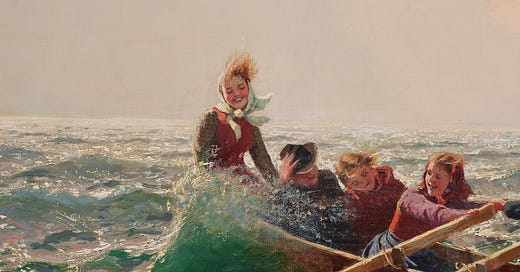


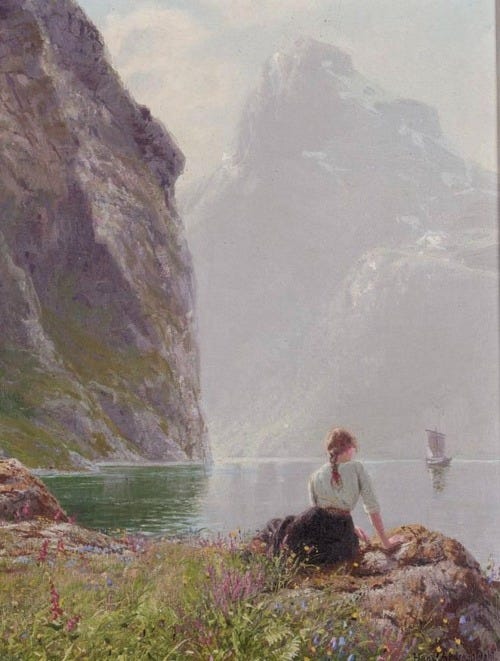
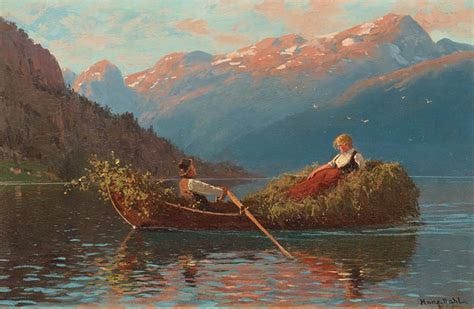

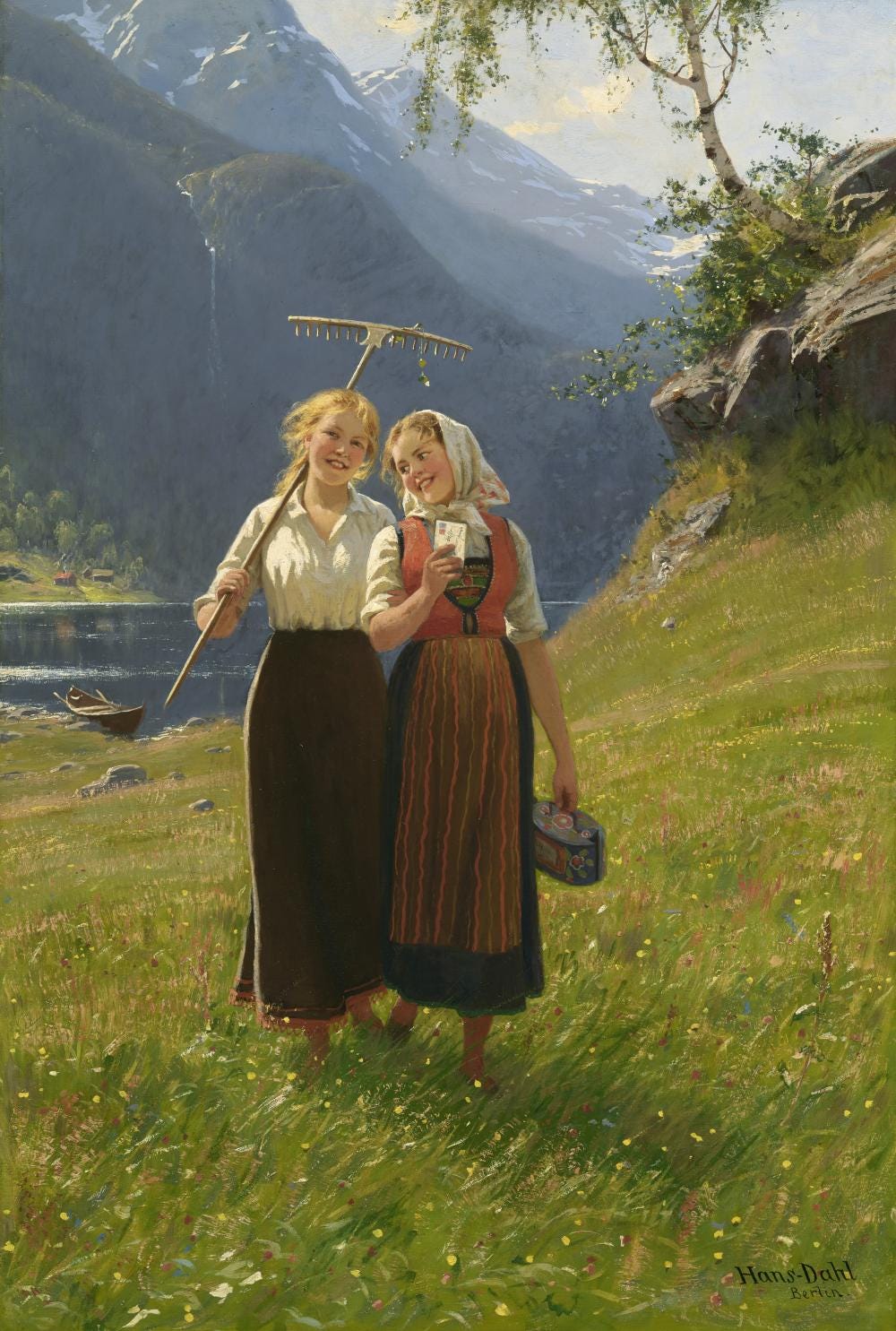
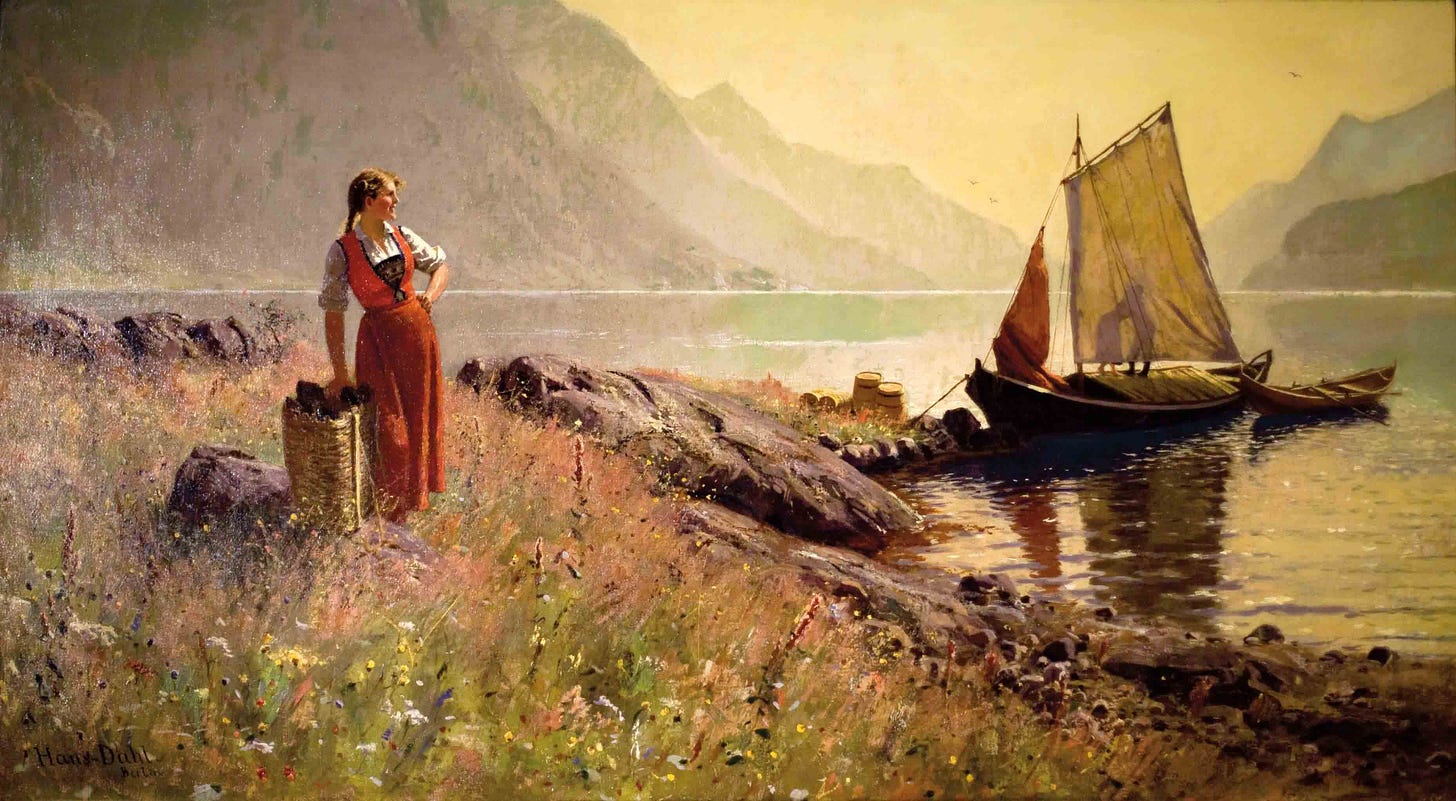
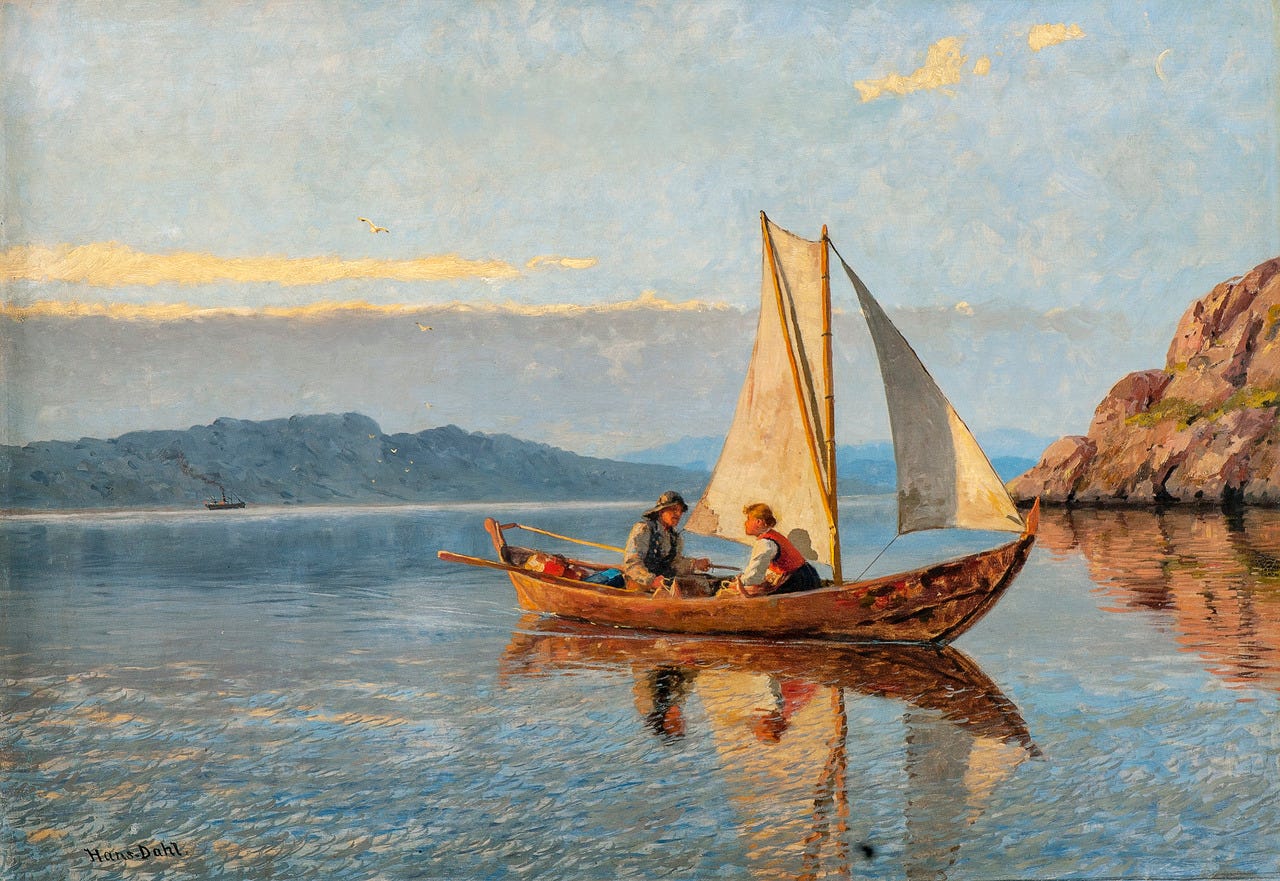




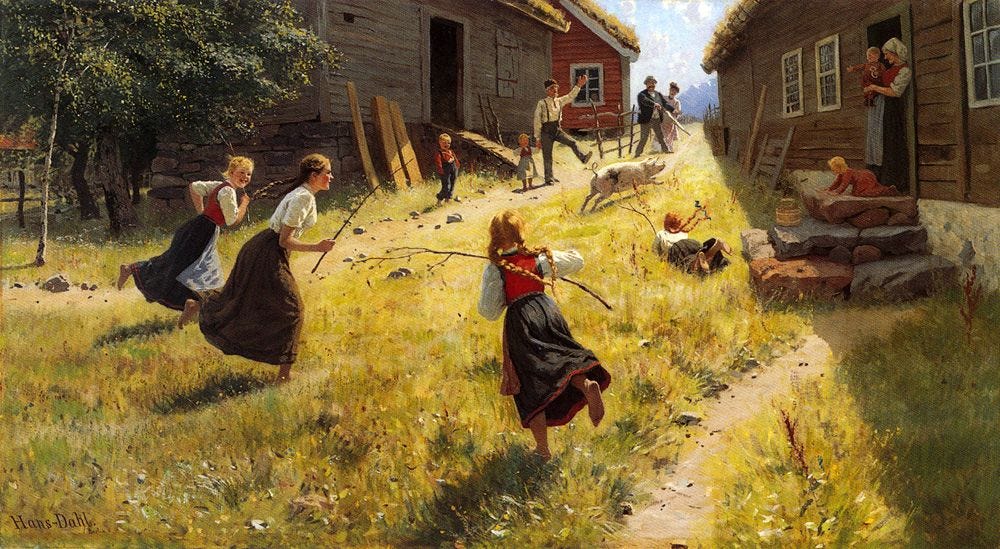
Wow, beautiful paintings, wonderful write-up. Best wishes for Australia. Wish you could pack me into your suitcase.